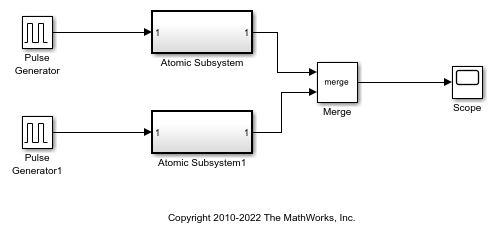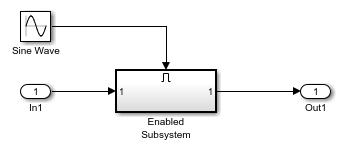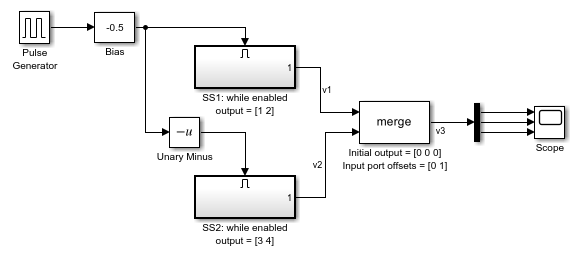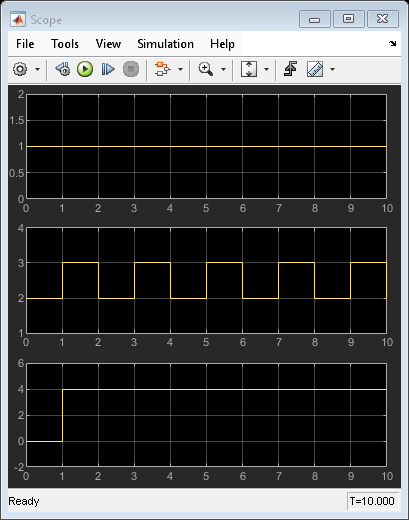Merge
Combine multiple signals into single signal
Libraries:
Simulink /
Signal Routing
HDL Coder /
Ports & Subsystems
Description
The Merge block combines inputs into a single output. The output value at any time is equal to the most recently computed output of its driving blocks. Specify the number of inputs by setting the Number of inputs parameter.
Use a Merge block to interleave input signals that update at different times into a combined signal in which the interleaved values retain their separate identities and times. To combine signals that update at the same time into an array or matrix signal, use a Concatenate block.
Guidelines for Using the Merge Block
When you use the Merge block, follow these guidelines:
Always use conditionally executed subsystems to drive Merge blocks, without any intervening blocks.
Ensure that at most one of the driving conditionally executed subsystems executes at any time step.
Ensure that all input signals have the same sample time.
Do not branch a signal that is input to a Merge block.
Do not log a signal that is input to a Merge block.
Do not specify the block execution priority of a Merge block. For more information, see Specify Block Execution Order, Execution Priority, and Tag.
For all conditionally executed subsystem Outport blocks that drive Merge blocks, set Output when disabled to
held.If the output of a Model block is coming from a MATLAB Function block or a Stateflow® chart, do not connect that output port to the input port of the Merge block.
The Merge block supports merging signals in different tasks to a root Outport block.
For each input of a Merge block, the topmost nonvirtual source must be a conditionally executed subsystem (not including a For Iterator or While Iterator subsystem).
The next diagram shows valid Merge block usage, merging signals from two conditionally executed subsystems.

Bus Support
The Merge block is a bus-capable block. The inputs can be virtual or nonvirtual bus signals subject to these restrictions:
The number of inputs must be greater than one.
Initial output must be zero, a nonzero scalar, or a finite numeric structure.
The Allow unequal port widths check box must be cleared.
All inputs must be buses and must be equivalent (same hierarchy with identical names and attributes for all elements).
All signals in a nonvirtual bus input to a Merge block must have the same sample time. You can use a Rate Transition block to change the sample time of an individual signal, or of all signals in a bus.
Merging S-Function Outputs
The Merge block can merge a signal from an S-Function block
only if the memory used to store the output from the S-Function block
is reusable. Simulink® displays an error message if you attempt to update or simulate a model
that connects a nonreusable port of an S-Function block to a
Merge block. See ssSetOutputPortOptimOpts.
Multi-tasked Root Outputs
A Merge block connected to a root Outport block allows merging signals in different tasks by allowing those signals to write to the root Outport block simultaneously. A Union sample time of the sources is assigned to the Merge block.
All the sources of the Merge block that are in the same task should be inside conditionally executed subsystems that should not output simultaneously in the same time step.
Examples
Extended Examples
Limitations
All signals that connect to a Merge block are functionally the same signal. Therefore, they are subject to the restriction that a given signal can have at most one associated signal object. See
Simulink.Signalfor more information.Run-time diagnostics do not run if the inputs to a Merge block are from a single initiator. For example, a single initiator could be a Stateflow chart executing function-call subsystems that are connected to a Merge block.
Do not set the outports of conditionally executed subsystems being merged to reset when disabled. This action can cause multiple subsystems to update the block at the same time. Specifically, the disabled subsystem updates the Merge block by resetting its output, while the enabled subsystem updates the block by computing its output.
To prevent this behavior, set the Outport block parameter Output when disabled to
heldfor each conditionally executed subsystem being merged.A Merge block does not accept input signals whose elements have been reordered or partially selected, as shown in the next diagram.
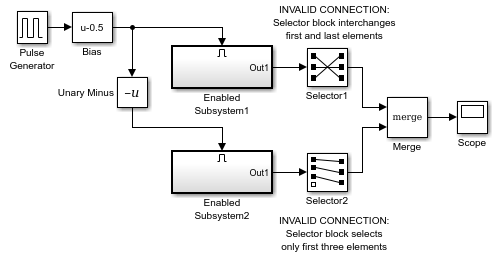
Do not connect input signals to the block that have been combined outside of a conditionally executed subsystem.
You can use an array of buses as an input signal to a Merge block with these limitations:
Allow unequal port widths — Clear this parameter.
Initial condition — You can specify this parameter using:
The value
0. In this case, each of the individual signals in the array of buses use the initial value0.An array of structures that specifies an initial condition for each of the individual signals in the array of buses.
A scalar structure that specifies an initial condition for each of the elements that the bus type defines. Use this technique to specify the same initial conditions for each of the buses in the array.
Ports
Input
Output
Parameters
Block Characteristics
Data Types |
|
Direct Feedthrough |
|
Multidimensional Signals |
|
Variable-Size Signals |
|
Zero-Crossing Detection |
|
Extended Capabilities
Version History
Introduced before R2006a
